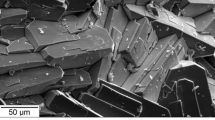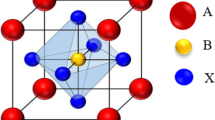Abstract
A multi-methodical approach has been applied for characterizing the bulk and surface crystal chemical features of a high-temperature vesuvianite crystal from skarns of Mount Somma-Vesuvius Volcano (Naples, Italy). Vesuvianite belongs to the space group P4/nnc with unit cell parameters a = 15.633(1) Å, c = 11.834(1) Å and chemical formula (Ca18.858 Na0.028 Ba0.004 K0.006 Sr0.005 □0.098)19.000 (Al8.813 Ti0.037 Mg2.954 Mn0.008 Fe 2+0.114 Fe 3+1.375 Cr0.008 B0.202)13.511 Si18.000(O0.261 F0.940 OH7.799)9.000. Structure refinement, which converges at R = 0.0328, demonstrates a strong positional disorder down the fourfold axes, indicating that the Y1 site is split into two positions (Y1A and Y1B) alternatively occupied. However, because of X4 proximity to Y1B and Y1A, X4 cannot be occupied if Y1B or Y1A are. Overall Y1 occupancy (Y1A + Y1B) reaches approximately 0.5, as common in vesuvianite and occupancy of Y1B site is extremely limited. Moreover, T1 position, limitedly occupied, accommodates the excess of cations generally related to Y position. A small quantity (0.202 apfu) of boron is sited at the T2 site that, like T1, is poorly occupied. The determination of the amount of each element on the (100) vesuvianite surface, obtained through X-ray photoelectron spectroscopy high-resolution spectra in the region of the Si2p, Al2p, Mg1s, and Ca2p core levels, evidences that a greater amount of aluminum and a smaller amount of calcium characterize the surface with respect to the bulk. Although both of these features require further investigation, we may consider the Al increase can be related to preferential orientation of Al-rich sites on the (100) plane. Furthermore, the surface structure of vesuvianite suggests that Al, Ca, and Mg cations maintain coordination features at the surface similar to the bulk. Silica, however, while presenting fourfold coordination, shows also a [1]-fold small coordinated component at binding energy 99.85 eV, due to broken Si–O bonds at the surface. The presence of eight- and nine-coordinated Ca cations is suggested by a large XPS feature resulting from the merging of Ca2p3/2 and Ca2p1/2 peaks at 348.45 and 352.05 eV, respectively.




Similar content being viewed by others
References
Allen FM, Burnham CW (1992) A comprehensive structure-model for vesuvianite: symmetry variations and crystal growth. Can Mineral 30:1–18
Armbruster T, Gnos E (2000a) P4/n and P4nc long-range ordering in low-temperature vesuvianites. Am Mineral 85:563–569
Armbruster T, Gnos E (2000b) “Rod” polytypism in vesuvianite: crystal structure of a low-temperature P4nc vesuvianite with pronounced octahedral cation ordering. Schweizerische Mineral Petrogr Mitteilungen 80:109–116
Armbruster T, Gnos E (2000c) Tetrahedral vacancies and cation ordering in low-temperature Mn-bearing vesuvianites: indication of a hydrogarnet-like substitution. Am Mineral 85:570–577
Barr TL, Seal S, Wozniak K, Klinowaki J (1997) ESCA studies of the coordination state of aluminum in oxide environments. J Chem Soc Faraday Trans 93:181–186. doi:10.1039/a604061f
Biino GG, Gröning P (1998) X-Ray Photoelectron Spectroscopy (XPS) used as a structural and chemical surface probe on aluminosilicate minerals. Eur J Mineral 10:423–437
Britvin SN, Antonov AA, Krivovichev SV, Armbruster T, Burns PC, Chukanov NV (2003) Fluorovesuvianite Ca19(Al, Mg, Fe2+)13(SiO4)10(Si2O7)4O(F, OH)9 a new mineral species from Pitkäranta, Karelia, Russia: description and crystal structure. Can Mineral 41:1371–1380. doi:10.2113/gscanmin.41.6.1371
Bruker (1999) SMART and SAINT-Plus, version 6.01. Bruker AXS, Madison
Cowan RD (ed) (1981) The theory of atomic structure and spectra (Los Alamos series in basic and applied sciences 3). University of California Press, Berkley
de Groot FMF, Kotani A (eds) (2008) Core level spectroscopy of solids (advances in condensed matter science). CRC Press, Boca Raton
Donovan JJ (1995) PROBE: PC-based data acquisition and processing for electron microprobes. Adv Microbeam, 4217 King Graves Rd., Vienna, Ohio, 44473
Elmi C, Brigatti MF, Pasquali L, Montecchi M, Laurora A, Malferrari D, Nannarone S (2010) Crystal chemistry, surface morphology and X-ray photoelectron spectroscopy of Fe-rich osumilite from Mt. Arci, Sardinia (Italy). Phys Chem Minerals 37:561–569. doi:10.1007/s00269-010-0357-4
Fitzgerald SF, Rheingold AR, Leavens PB (1986) Crystal structure of a non-P4/nnc vesuvianite from Asbestos, Quebec. Am Mineral 71:1483–1488
Fitzgerald S, Leavens PB, Nelen JA (1992) Chemical variation in vesuvianite. Mineral Petrol 46:163–178
Galuskin EV, Armbruster T, Malsy A, Galuskina IO, Sitarz M (2003) Morphology, composition and structure of low-temperature P4/nnc high-fluorine vesuvianite whiskers from Polar Yakutia, Russia. Can Mineral 41:843–856. doi:10.2113/gscanmin.41.4.843
Galuskin EV, Galuskina IO, Stadnicka K, Armbruster T, Kozanecki M (2007) The crystal structure of Si-deficient OH-substituted boron-bearing vesuvianite from the Wiluy river, Sakha-Yakutia, Russia. Can Mineral 45:239–248. doi:10.2113/gscanmin.45.2.239
Giuseppetti G, Mazzi F (1983) The crystal structure of a vesuvianite with P4/n symmetry. Mineral Petrol 31:277–288. doi:10.1007/BF01081374
Gnos E, Armbruster T (2006) Relationship among metamorphic grade vesuvianite “rod polytypism” and vesuvianite composition. Am Mineral 91:862–870. doi:10.2138/am.2006.1973
Groat LA, Hawthorne FC, Ercit TS (1992) The chemistry of vesuvianite. Can Mineral 30:19–48
Groat LA, Hawthorne FC, Ercit TS, Putnis A (1993) The symmetry of vesuvianite. Can Mineral 31:617–635
Groat LA, Hawthorne FC, Ercit TS (1994) The incorporation of boron into the vesuvianite structure. Can Mineral 32:505–523
Groat LA, Hawthorne FC, Lager GA, Schultz AJ, Ercit TS (1996) X-ray and neutron crystal refinements of a boron-bearing vesuvianite. Can Mineral 34:1059–1070
Himpsel FJ, McFeely FR, Taleb-Ibrahimi A, Yarmoff JA, Hollinger G (1988) Microscopic structure of the silica/silicon interface. Phys Rev B: Condens Matter Mater Phys 38:6084–6096. doi:0.1103/PhysRevB.38.6084
Lager GA, Xie Q, Ross FK, Rossman GR, Armbruster T, Rotella FJ, Schultz AJ (1999) Hydrogen-atom positions in P4/nnc vesuvianite. Can Mineral 37:763–768
Malczewski D, Frąckowiak JE, Galuskin EV (2005) 57Fe Mössbauer spectroscopy and X-ray diffraction study of some complex metamict minerals. Hyperfine Interact 166:529–536. doi:10.1007/s10751-006-9321-6
Muilenberg GE (ed) (1979) Handbook of X-ray photoelectron spectroscopy. Physical Electronics Division, Perkin-Elmer Corp, Norwalk
Nyunt TT, Theye T, Massonne HJ (2009) Na-rich vesuvianite in jadeitite of the Tawmaw jade district, Northern Myanmar. Period Mineral 78:5–18. doi:10.2451/2009PM0009
Ohkawa M, Yoshiasa A, Takeno S (1992) Crystal chemistry of vesuvianite: site preferences of square-pyramidal coordinated sites. Am Mineral 77:945–953
Ohkawa M, Armbruster T, Galuskin E (2009) Structural investigation of low-symmetry vesuvianite collected from Tojyo, Hiroshima, Japan: implications fro hydrogarnet-like substitution. J Mineral Petrol Sci 104:69–76. doi:10.2465/jmps.080507
Pavese A, Prencipe M, Tribaudino M, Aagaard SS (1998) X-ray and neutron single crystal study of P4/n vesuvianite. Can Mineral 36:1029–1037
Rucklidge JC, Kocman V, Whitlow SH, Gabe EJ (1975) The crystal structure of three Canadian vesuvianites. Can Mineral 13:15–21
Rusakov VS, Kovalchuk RV, Borovikova EY, Kurazhkovskaya YS (2006) State of iron atoms in high vesuvianites according to Mössbauer spectroscopy data (in Russian, English abstract). Zapiski Vserossijskogo mineralogičeskogo obŝestva 135:91–100
Sheldrick GM (1996) SADABS. University of Göttingen, Germany
Sheldrick GM (1997) SHELXL97. Program for the Refinement of Crystal Structures. University of Göttingen, Germany
Shirley DA (1972) Effect of atomic and extra-atomic relaxation on atomic binding energies. Chem Phys Lett 16:220–225. doi:10.1016/0009-2614(72)80260-4
Smith GC (2005) Evaluation of a simple correction for the hydrocarbon contamination layer in quantitative surface analysis by XPS. J Electron Spectrosc Relat Phenom 148:21–28. doi:10.1016/j.elspec.2005.02.004
Tribaudino M, Prencipe M (1999) A high temperature in situ single-crystal study of P4/n vesuvianite. Eur J Mineral 11:1037–1042
Tricker MJ, Vaishnava PP, Manning PG (1981) 57Fe Mössbauer scpectroscopic studies of electron-hopping processes in vesuvianites. J Inorg Nucl Chem 43:1169–1174
van Aken PA, Liebscher B, Styrsa VJ (1998) Quantitative determination of iron oxidation states in minerals using Fe L2, 3-edge electron energy-loss near-edge structure spectroscopy. Phys Chem Minerals 25:323–327
Warren BE, Modell DI (1931) The structure of vesuvianite Ca10Al4(Mg, Fe)2Si9O34(OH)4. Z Krist 78:422–432
Zakaznova-Herzog VP, Nesbitt HW, Bancroft GM, Tse JS (2008) Characterization of leached layers on olivine and pyroxenes using high-resolution XPS and density functional calculations. Geochim Cosmochim Acta 72:69–86. doi:10.1016/j.gca.2007.09.031
Acknowledgments
Our research is supported by Italian Ministero dell’Istruzione Università e Ricerca (MIUR) under project PRIN 2008. XAS spectra were collected at ELETTRA Synchrotron at Trieste. We would also kindly thank Dr. Federico Spizzo (Laboratory of Mössbauer spectroscopy, Università di Ferrara) for precious help in the analysis and interpretation of Mössbauer spectrum and Dr. Daniela Manzini (Centro Interdipartimentale Grandi Strumenti (CIGS), Università di Modena e Reggio Emilia) for her valuable support in the use of LA-ICP-MA. We thank Catherine McCammon and L.A. Groat for their critical readings of the manuscript, helpful corrections and additions to its contents.
Author information
Authors and Affiliations
Corresponding author
Electronic supplementary material
Below is the link to the electronic supplementary material.
Rights and permissions
About this article
Cite this article
Elmi, C., Brigatti, M.F., Pasquali, L. et al. High-temperature vesuvianite: crystal chemistry and surface considerations. Phys Chem Minerals 38, 459–468 (2011). https://doi.org/10.1007/s00269-011-0419-2
Received:
Accepted:
Published:
Issue Date:
DOI: https://doi.org/10.1007/s00269-011-0419-2




